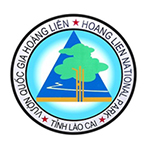It is important that amphibian are conserved as they provide important ecosystem services. The loss of one or more species can reduce the quality of the services within an ecosystem as amphibians play a critical role in nutrient cycling and energy flow in both aquatic and terrestrial ecosystems. The removal of amphibians from, or reduction in numbers of amphibians in, a system can have dire consequences. For example, the over collection of frogs for the meat trade resulted in an increase in agricultural pests in India. Amphibians also have an economic value; they are used for food, medicines, research and are increasingly popular as pets
News
WHY CONSERVE AMPHIBIANS?
Many amphibians feed on insects which can damage crops and spread disease. Energy transfer between land and water, removal of algae from aquatic habitats. Many amphibians are know to secrete chemicals from their skin some of which have already been used to develop treatments for human disease. Amphibians are significant to many cultures around the world. Amphibians are an extremly sensitive group of animals, they are indicators of ecosystem health. Amphibians are an important source of food for many others animals.
PEST CONTROL

ECOSYSTEMS SERVICES

PHARMACEUTICALS

CULTURAL AND AESTHETIC VALUE

INDICATOR SPECIES

FOOD

Frogs of Fansipan
The amphibians of Indochina are both poorly known and highly threatened. Facing amongst the highest deforestation rate on the planet, and over-harvesting pressure, Southeast Asian amphibians are being driven towards an extinction crisis. One of the biggest obstacles facing amphibian conservation in the region is our lack of knowledge of amphibians. As such, it is vital that surveys and taxonomic research along with population monitoring continues so that the true patterns of diversity can be revealed and population declines detected. There is an urgent need to prioritise both species and habitats that require protection. One of the most important areas in the region for amphibian diversity and endemism is the Hoang Lien Range, home to more the 80 species of amphibian, some of which are restricted to very small areas and are the most threatened amphibian species in mainland Southeast Asia.
The higher elevations of Hoang Lien National Park are important sites for biodiversity, and are the only known location for Vietnam’s only confirmed Critically Endangered amphibians, Sterling’s Toothed Toad, Oreolalax sterlingae and Botsford’s Leaf-litter Frog, Leptolalax botsfordi. Both species became known to science recently, being scientifically described in only 2013. The habitat of both species is threatened by human activities, particularly tourism. Fortunately, as the impacts of tourism can be minimised, many of the associated threats facing the species are potentially reversible.
Actions required
This action plan will involve international collaboration and a long term commitment from all partners and could be used as a model for other taxonomic groups and areas within the region.
Priority actions identified to ensure the long term conservation of amphibians in the Hoang Lien Range are:
- The strict protection of key breeding sites including access restriction so that habitats can recover and pollution of the streams minimised;
- Priority amphibian species receive full and active protection by the Vietnamese government and that amphibians are considered when future developments in these upland areas are designed and implemented;
- Long-term population monitoring of the priority amphibian species;
- Comprehensive inventories of the amphibian diversity of the Hoang Lien Range so that areas and species in need of conservation attention are identified;
- The development of a Communication, Education and Public Awareness programme (CEPA) aimed at encouraging behavioural changes that benefit biodiversity.
Sterling’s Toothed Frog
- Oreolalax sterlingae -
is the only representative of its genus that has been reported from Vietnam. A medium-sized frog (~4cm body size) that has only been reported from bamboo forest associated with rocky rivulets and rocky streams and elfin moss forest. The tadpole of the species was recently encountered and a formal scientific description is in preparation. Its vocalisation has not been described. At present, the species is only known from a single stream at ~2,800 m asl up to near the summit at >3,000 m asl on Mount Fansipan and is thought to be extremely geographically restricted, with an extent of occurrence (EOO) of only 8 km2, representing a single threat-defined location. It is possible that the range of the species may include some of the few small, isolated areas above 2,700 m asl in other parts of the Hoang Lien Range. However, such areas are >20 km away and separated by elevations under 1,000 asl, making the species’ dispersal to these parts unlikely.
Botsford’s leaf-litter frog
- Leptolalax botsfordi -
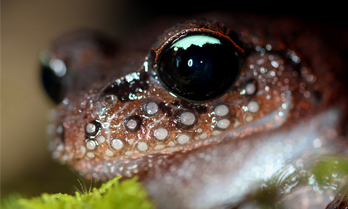
Ailao moustached frog
Leptobrachium aliaonicum
Male Ailao moustached frogs develop nuptial spines on their faces during the breeding season. Adult frogs are often found close to forest streams where they breed. The male frogs construct and guard nests under rocks in streams, aggressively defending nesting sites and eggs against other males by jostling them with their spines. Male frogs call from underwater to attract the females. The streams they breed in are cool and tadpoles may take several years to metamorphose and during this time may reach a total length of nearly 12 cm. On Mount Fansipan this species has been reported from elevations between 1,900 and 2,500 m asl.
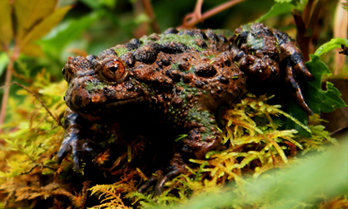
Giant fire bellied toad
Bombina maxima
Giant fire bellied toads are not well studied in Vietnam. Despite the name, this species grows up to 65 mm snout vent length. The underside of this species is brightly coloured with orange and black to warn predators of this frogs toxicity. When threatened the giant fire bellied toad may flip onto its back and expose the brightly coloured underside. On Mount Fansipan this frog has been reported to occur between 2,050 and 2,200 m asl in montane evergreen forest. This species has not been formerly assessed by the IUCN Red List of Threatened Species.
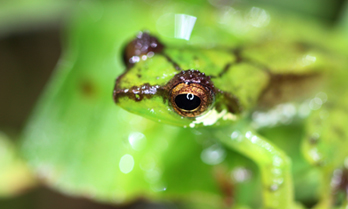
Chapa bubble-nest frog
Gracixalus gracilipes
The Chapa bubble-nest frog is a diminutive green frog, males reach up to 25 mm snout to vent length. These frogs have pointed snouts, green blood and turquoise bones. Females deposit eggs in clear jelly on leaves and branches above non flowing water. In Hoang Lien National Park this species can be found in grassy swamps and ditches between elevations of 1,540-1,890 m asl. The Chapa bubble-nest frog has a relatively sophisticated signalling system, calls consist of a series of highly variable, non-stereotypical calls including clicks and whistles. This species is assessed as Least Concern by the IUCN Red List of Threatened Species.

Mao-Son horned frog
Megophrys maosonensis
The Mao-Son horned frog is associated with large rivers that can be found at lower elevations in Hoang Lien National Park between 1,500-1,700 m asl. This species is only known from northern Vietnam and Yunnan in China. This species differs from other Horned Frogs in Hoang Lien National Park by the broad white bar on the upper lip and their large size (up to 100 mm). The tadpoles of horned frogs have funnel shaped mouthparts and they feed on particles at the water surface. These frogs are consumed by people. This species has not been formerly assessed by the IUCN Red List of Threatened Species.
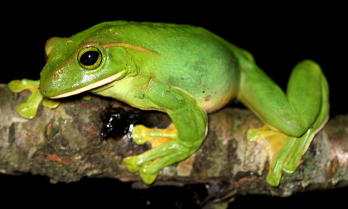
Fea’s treefrog
Rhacophorus feae
Feae’s gliding frog is Vietnam’s largest treefrog and the reach a snout vent length of the dorsal surface is green, and the Iris colouration is also green. These arboreal frogs have prominent interdigital webbing. They are foam nesting treefrogs and construct foam nests in vegetation above or beside streams, ponds and paddy fields and holes in trees. The eggs hatch out within the foam and then the tadpoles drop down into the water below. These frogs are associated with closed canopy evergreen forest and in Hoang lien National Park have been reported between and 1,230-1,800 m asl. This species is assessed as Least Concern by the IUCN Red List of Threatened Species.
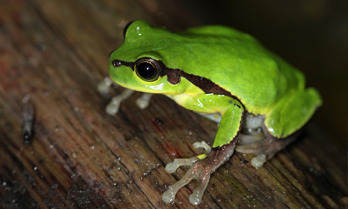
Jerdon’s treefrog
Hyla annectans
Jerdon’s treefrog is a widely distributed species from central and southwest China, northeast India, northern Thailand, northern Myanmar and northern Vietnam. They are small frogs, males grow up to 40 mm snout vent length and females reach 48 mm snout vent length. The dorsum is green and the frogs have a brown bar running from the nostril, through the tympanum and into the inguinal region where it terminates. These frogs are largely arboreal and associated with evergreen forests, grassland and rice paddies. In Hoang Lien National Park this frog can be found between 1,260 and 2,090 m asl. This species is assessed as Least Concern by the IUCN Red List of Threatened Species.
Threats to Focal Species
The most immediate threat to these species include habitat degradation associated with tourism. At the time that this species was described considerable pollution by garbage and runoff from toilets is recorded very close to the streams used by the species. The construction of a cable car from Sapa to the summit of Mount Fansipan and associated developments on the summit is also likely to affect them. The historic burning and subsequent ecosystem conversion of the summit of Mount Fansipan and adjacent areas, which are thought to have been previously covered in forest, is also likely to have reduced habitat quality. The restriction of these species to high altitudes near the mountain peaks is likely to present an issue as tropical montane forests are expected to be particularly prone to alteration by climate change. Strategies for additional protection of habitat within its range may be warranted as habitat degradation caused by tourism continues to be a threat. Further research into the species’ ecology, distribution, relative population abundance, and past and current population trends would improve conservation decisions as very little is known about these species at present. These species do not receive any legal protection under Vietnamese law.
PARTNERS
ZSL
Zoological Society of LondonAustralian Museum
Hoang Lien
National ParkPaignton Zoo
Centre for Rescue and
Conservation of OrganismThe EDGE of Existence
Amphibian Survival Alliance
IUCN Red List
of Threatened SpeciesIndo-Myanmar
ConservationThe Asian Turtle
Program





